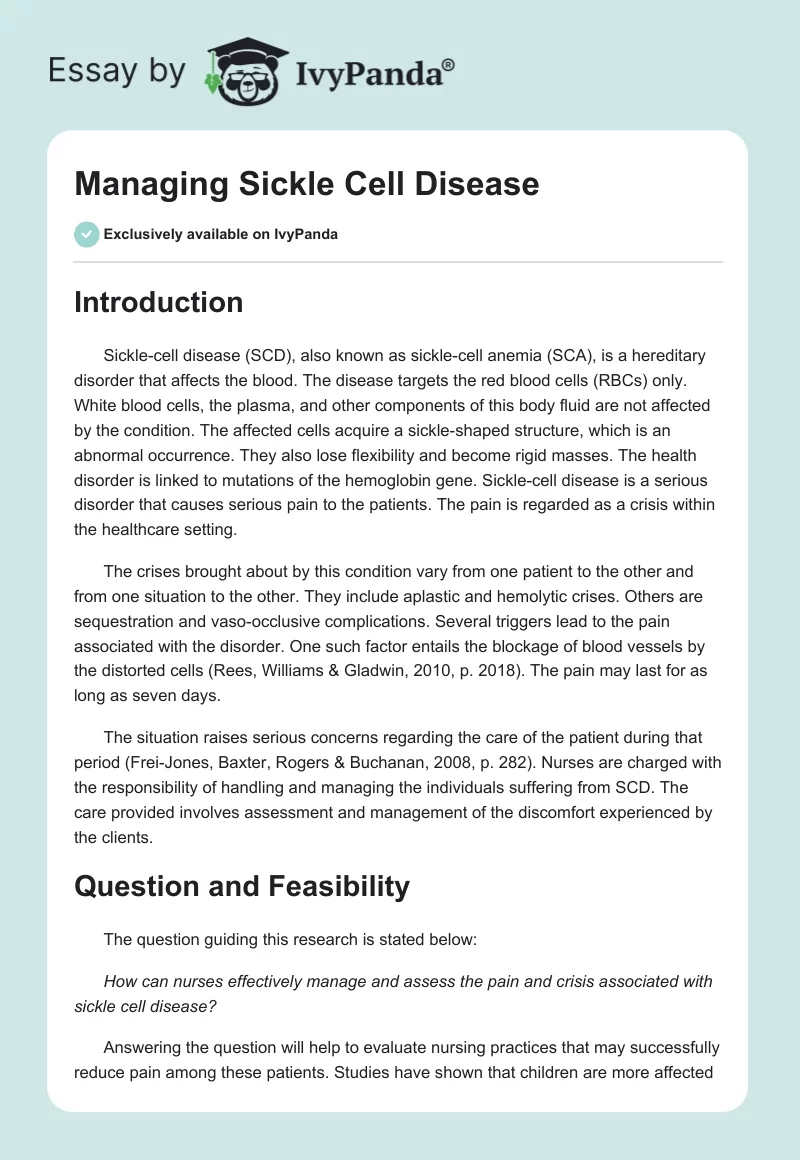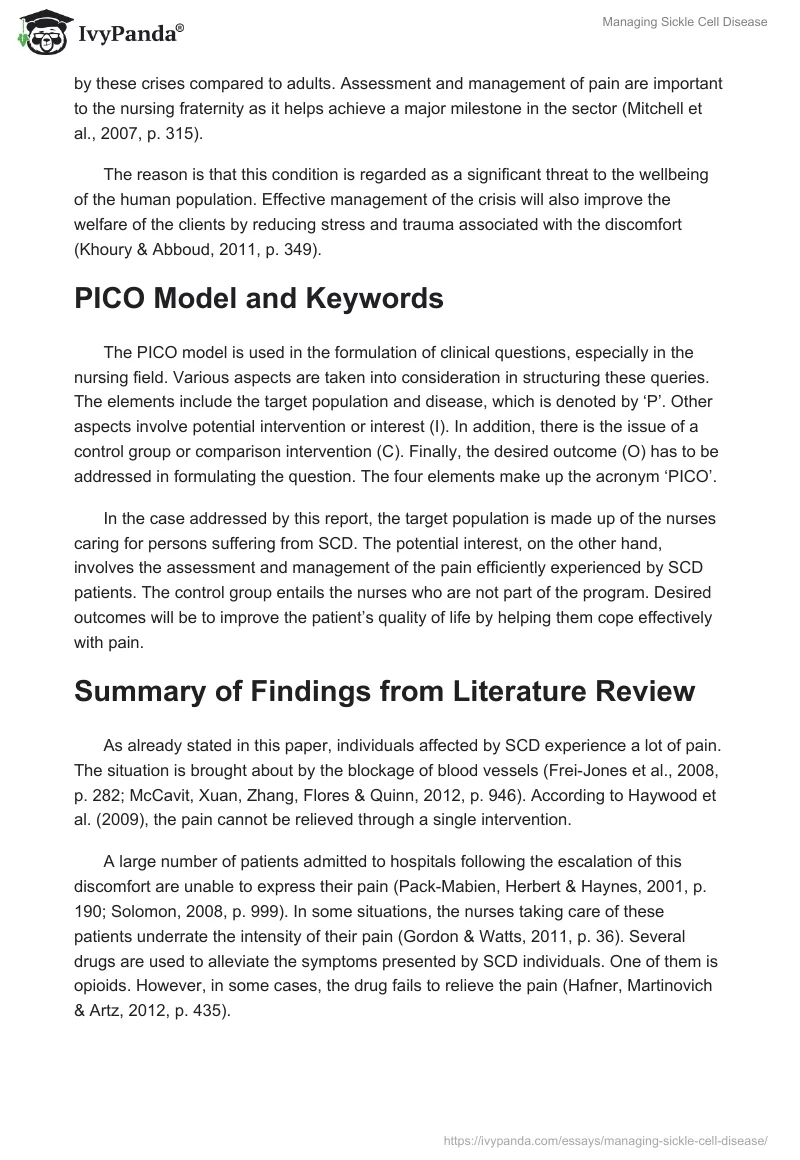Introduction
Sickle-cell disease (SCD), also known as sickle-cell anemia (SCA), is a hereditary disorder that affects the blood. The disease targets the red blood cells (RBCs) only. White blood cells, the plasma, and other components of this body fluid are not affected by the condition. The affected cells acquire a sickle-shaped structure, which is an abnormal occurrence. They also lose flexibility and become rigid masses. The health disorder is linked to mutations of the hemoglobin gene. Sickle-cell disease is a serious disorder that causes serious pain to the patients. The pain is regarded as a crisis within the healthcare setting.
The crises brought about by this condition vary from one patient to the other and from one situation to the other. They include aplastic and hemolytic crises. Others are sequestration and vaso-occlusive complications. Several triggers lead to the pain associated with the disorder. One such factor entails the blockage of blood vessels by the distorted cells (Rees, Williams & Gladwin, 2010, p. 2018). The pain may last for as long as seven days.
The situation raises serious concerns regarding the care of the patient during that period (Frei-Jones, Baxter, Rogers & Buchanan, 2008, p. 282). Nurses are charged with the responsibility of handling and managing the individuals suffering from SCD. The care provided involves assessment and management of the discomfort experienced by the clients.
Question and Feasibility
The question guiding this research is stated below:
How can nurses effectively manage and assess the pain and crisis associated with sickle cell disease?
Answering the question will help to evaluate nursing practices that may successfully reduce pain among these patients. Studies have shown that children are more affected by these crises compared to adults. Assessment and management of pain are important to the nursing fraternity as it helps achieve a major milestone in the sector (Mitchell et al., 2007, p. 315).
The reason is that this condition is regarded as a significant threat to the wellbeing of the human population. Effective management of the crisis will also improve the welfare of the clients by reducing stress and trauma associated with the discomfort (Khoury & Abboud, 2011, p. 349).
PICO Model and Keywords
The PICO model is used in the formulation of clinical questions, especially in the nursing field. Various aspects are taken into consideration in structuring these queries. The elements include the target population and disease, which is denoted by ‘P’. Other aspects involve potential intervention or interest (I). In addition, there is the issue of a control group or comparison intervention (C). Finally, the desired outcome (O) has to be addressed in formulating the question. The four elements make up the acronym ‘PICO’.
In the case addressed by this report, the target population is made up of the nurses caring for persons suffering from SCD. The potential interest, on the other hand, involves the assessment and management of the pain efficiently experienced by SCD patients. The control group entails the nurses who are not part of the program. Desired outcomes will be to improve the patient’s quality of life by helping them cope effectively with pain.
Summary of Findings from Literature Review
As already stated in this paper, individuals affected by SCD experience a lot of pain. The situation is brought about by the blockage of blood vessels (Frei-Jones et al., 2008, p. 282; McCavit, Xuan, Zhang, Flores & Quinn, 2012, p. 946). According to Haywood et al. (2009), the pain cannot be relieved through a single intervention.
A large number of patients admitted to hospitals following the escalation of this discomfort are unable to express their pain (Pack-Mabien, Herbert & Haynes, 2001, p. 190; Solomon, 2008, p. 999). In some situations, the nurses taking care of these patients underrate the intensity of their pain (Gordon & Watts, 2011, p. 36). Several drugs are used to alleviate the symptoms presented by SCD individuals. One of them is opioids. However, in some cases, the drug fails to relieve the pain (Hafner, Martinovich & Artz, 2012, p. 435).
Nurses and other professionals are of the view that the failure to effectively reduce pain with the use of this drug is brought about by addiction and resistance. The two (addiction and resistance) are brought about by overuse or misuse of the compound. Failure to adopt the evidence-based practice analyzed in this report may make the situation worse (Mitchell et al., 2007, p. 317; Mousa et al., 2010, p. 370)
Currently, most healthcare facilities lack specialized equipment to show pain scores (Van Beers et al., 2007, p. 958). As such, the nurses depend on reports made by the patients. Research has shown that early intervention with an opioid is effective in the management of the situation (Brown, Wickline, Ecoff & Glaser, 2009, p. 379).
Nursing Practice Supported By Evidence in Articles
The literature review makes it clear that the assessment of pain associated with SCD is important in managing the condition (Hafner et al., p. 432). Caregivers need a clear picture of the intensity of discomfort experienced by the patient. Pain scores are needed to determine the intensity of the crisis (Mousa et al., 2010, p. 373).
Self-report pain instruments can be used to guide the administration of various drugs, such as morphine and opioid. Health facilities that have used these tools report that most individuals admitted with SCD have a pain score of over 50 percent (Machado et al., 2011, p. 859). Nurses should not assume the intensity of the pain experienced by an individual. They should also not rely entirely on the oral report of crisis by patients.
Translating Evidence into Practice
Efficient assessment and management of pain will enable nurses to improve the quality of life of SCD patients. The introduction of specialized equipment will help practitioners assess the crisis effectively. The equipment will also help detect responses to the treatment intervention used. Failure to adopt the practice will increase mortality rates associated with SCD (Haywood et al., 2009, p. 1030). The situation may also lead to serious health complications, such as hemolytic crisis. In addition, patients are likely to prolong their stays in hospitals due to slow recovery.
Dissemination of Evidence
The evidence is best disseminated through the use of print and social media, as well as via healthcare seminars and conferences (Brown et al., 2009, p. 374). Communicating the importance of the practice to colleagues is also important (Thorsteinsson, 2013, p. 120). Organizing seminars and workshops will provide nurses with information on how to own the new system. Technicians are required to service and maintain the equipment. To reduce resistance to change, employees will be enlightened on the benefits of the new system (Brown et al., 2009, p. 380).
Conclusion
Most nurses underestimate the pain experienced by SCD patients. As a result, the majority of the individuals experience trauma, which may lead to neurological complications. By using specialized self-report pain instruments, nurses can effectively monitor the conditions of these patients. Their suffering can be alleviated if the caregivers use the evidence available to manage them.
The 3 Part Project Summary
The three parts of the project focus on sickle cell disease. In the first essay, the author formulated the PICO question to guide the research. The second and third sections delved more into this issue.
It was found that the condition is genetic. It distorts the shape of the red blood cells, making them resemble a sickle. The cells also become rigid, a condition that interferes with their functionality. They are unable to move through the blood capillaries. The situation results in the obstruction of these vessels, leading to severe pain. The discomfort associated with the disease is often referred to as an SCD crisis. In the past, patients were provided with drugs, such as opioids, to relieve the pain.
In the three projects, it was established that SCD has attracted the attention of professionals as a result of its lethal nature. It has a high mortality rate and is regarded by the World Health Organization as one of the factors behind low life expectancy. In most cases, patients suffering from SCD are cared for by nurses. The main duties of these caregivers include the administration of drugs. The practitioners also monitor the daily progress of the patients. They mainly focus on pain relief to improve the quality of life of the patient affected by the condition.
To effectively carry out their duties, nurses should have access to knowledge touching on the assessment and management of the pain associated with the condition. Research shows that it is possible to control the crisis associated with SCD if it is detected early. Specialized medical types of equipment are used to detect and manage the pain scores of these patients in a bid to improve the quality of care provided to them.
References
Brown, C., Wickline, M., Ecoff, L., & Glaser, D. (2009). Nursing practice, knowledge, attitudes, and perceived barriers to evidence‐based practice at an academic medical center. Journal of Advanced Nursing, 65(2), 371-381.
Frei-Jones, M., Baxter, A., Rogers, Z., & Buchanan, G. (2008). Vaso-occlusive episodes in older children with sickle cell disease: Emergency department management and pain assessment. Journal of Pediatrics, 152, 281-285.
Gordon, J., & Watts, C. (2011). Applying skills and knowledge: Principles of nursing practice. Nursing Standard, 25(33), 35-37.
Hafner, J., Martinovich, Z., & Artz, N. (2012). Adult emergency department patients with sickle cell pain crisis: results from a quality improvement learning collaborative model to improve analgesic management. Academic Emergency Medicine, 19(4), 430-438.
Haywood, C., Beach, M., Lanzkron, S., Strouse, J., Wilson, R., Park, H.,…Segal, J. (2009). A systematic review of barriers and interventions to improve appropriate use of therapies for sickle cell disease. Journal of the National Medical Association, 101, 1022-1033.
Khoury, R., & Abboud, M. (2011). Stem-cell transplantation in children and adults with sickle cell disease: An update. Expert Review of Hematology, 4(3), 343-351.
Machado, R., Barst, R., Yovetich, N., Hassell, K., Kato, G., Gordeuk,…Gladwin, M. (2011). Hospitalization for pain in patients with sickle cell disease treated with sildenafil for elevated TRV and low exercise capacity. Blood, 118(4), 855-864.
McCavit, T., Xuan, L., Zhang, S., Flores, G., & Quinn, C. (2012). Hospitalization for invasive pneumococcal disease in a national sample of children with sickle cell disease before and after PCV7 licensure. Pediatric Blood Cancer, 58(6), 945-949.
Mitchell, M., Lemanek, K., Palermo, T., Crosby, L., Nichols, A., & Powers, S. (2007). Parent perspectives on pain management, coping, and family functioning in pediatric sickle cell disease. Clinical Pediatrics, 46, 311-319.
Mousa, S., Al-Momen, A., Sayegh, F., Jaouni, S., Nasrullah, Z., Al Saeed, H.,…Qari, M. (2010). Review: Management of painful vaso-occlusive crisis of sickle-cell anemia: Consensus opinion. Clinical and Applied Thrombosis-Hemostasis, 16(4), 365-376.
Pack-Mabien, A., Herbert, L., & Haynes, J. (2001). Nurses’ attitudes and practices in sickle cell pain management. Applied Nursing Research, 14(4), 187-192.
Rees, D., Williams, T., & Gladwin, M. (2010). Sickle-cell disease. Lancet, 376(9757), 2018-2031.
Solomon, L. (2008). Treatment and prevention of pain due to vaso-occlusive crises in adults with sickle cell disease: an education void. The American Society of Hematology, 111, 997-1003.
Thorsteinsson, H. (2013). Icelandic nurses’ beliefs, skills, and resources associated with evidence-based practice and related factors: A national survey. Worldviews on Evidence-Based Nursing, 10(2), 116-126.
Van Beers, E., Van Tujin, C., Nieuwkerk, P., Friederich, P., Vranken, J., & Biemond, B. (2007). Patient-controlled analgesia versus continuous infusion of morphine during vaso-occlusive crisis in sickle cell disease, a randomized controlled trial. American Journal of Hematology, 82, 955-960.


